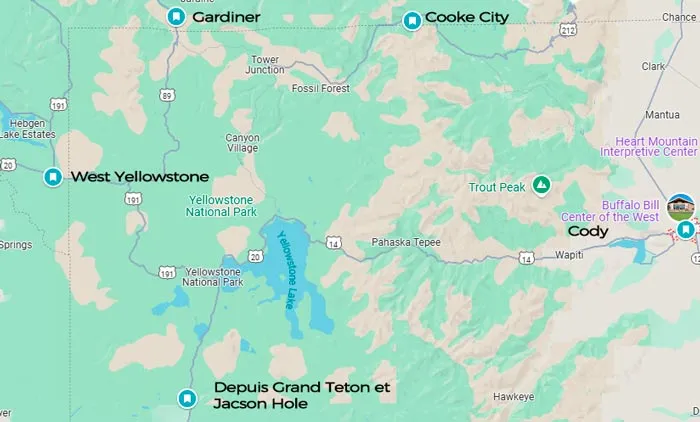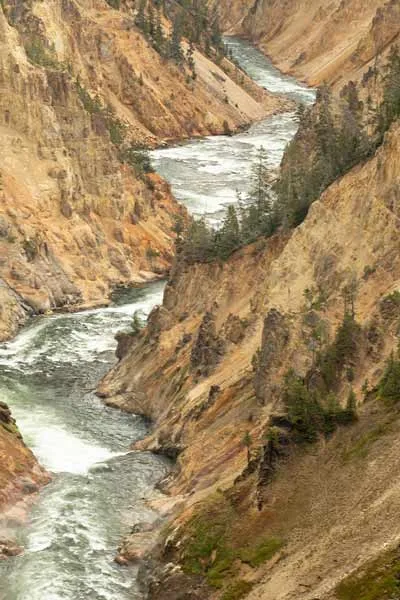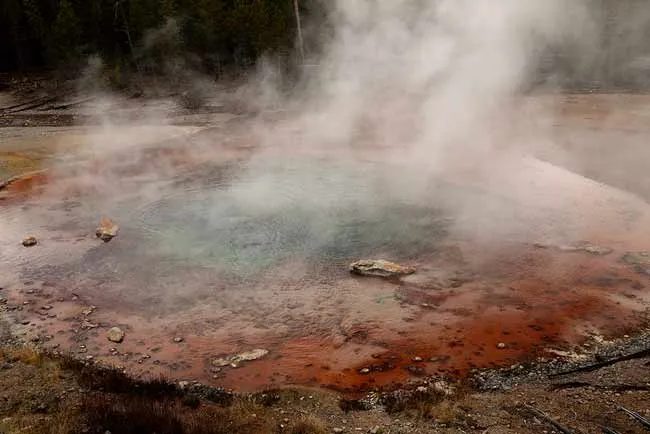Yellowstone, the first national park in the United States and one of the last great wild ecosystems on Earth, offers an unforgettable adventure for the whole family. Situated atop a dormant supervolcano, Yellowstone is a world of geothermal wonders, from towering geysers like Old Faithful to colorful hot springs like Grand Prismatic Spring. Moreover, it’s home to a plethora of wildlife, from majestic bison and graceful elk to elusive grizzly bears and mysterious gray wolves. A family trip to Yellowstone is more than just a vacation; it’s an opportunity to bond with family members, explore the magnificent beauty of nature together, and create lifelong memories.
Recognized by UNESCO as a World Heritage Site, Yellowstone spans over 9,000 km², primarily in Wyoming, extending into Montana and Idaho. With five entrances and a vast network of roads, planning a trip can feel a bit overwhelming. However, don’t worry, this article will share the most detailed and helpful family travel tips for Yellowstone, helping you and your family have a complete and memorable exploration journey. We will explore must-see attractions, activities suitable for all ages, tips for a smooth and safe trip, as well as itinerary and accommodation suggestions. Let’s pack our bags and embark on a journey to explore the magical land of Yellowstone!
Preparing for a Family Trip to Yellowstone
To have a smooth and memorable Yellowstone family vacation, thorough preparation is essential. Here are some factors to consider before starting your journey:
Ideal Time to Visit Yellowstone
Summer (June to August) is the most popular time to visit Yellowstone, as the weather is warm and pleasant, and all roads and attractions are open. However, this is also peak season, the park will be very crowded, and service prices are higher. If you want to avoid crowds and save costs, spring (April – May) and fall (September – October) are excellent choices. In spring, you can witness the fresh scenery of nature, and wildlife is more active. Autumn brings brilliant fall foliage and fresh, cool air. Winter (November – March) in Yellowstone is very cold and snowy, and some roads and attractions may be closed. However, if you love winter sports like cross-country skiing, snowshoeing, and want to experience a peaceful, quiet Yellowstone, winter is also a unique option.
Transportation and Entrance Fees
To explore Yellowstone most fully, renting a car is the ideal mode of transportation. You can drive along the beautiful park roads, stop at any attraction you want, and freely explore according to your family’s schedule. If you don’t want to drive yourself, you can join bus or jeep tours.
Like most national parks in the United States, Yellowstone charges an entrance fee. The current entrance fee is $35 per vehicle, valid for 7 consecutive days. If you plan to visit many other national parks during the year, you should purchase the America the Beautiful Pass for $80, valid for one year and allowing you free entry to all national parks and other federal recreation areas.

Yellowstone has 5 entrances:
- South Entrance: From Grand Teton and Jackson Hole
- North Entrance: From Gardiner
- Northeast Entrance: From Cooke City
- West Entrance: From West Yellowstone in Montana
- East Entrance: From Cody, Wyoming
Note that some roads may be seasonally closed, especially in winter, due to weather conditions. You should check for updated road conditions before you go.
Accommodation Booking and Packing
Booking accommodation in advance, especially during peak season, is essential when traveling to Yellowstone with family. You can choose to stay in hotels, lodges, cabins, or campgrounds within the park or in nearby towns such as West Yellowstone, Gardiner, or Jackson Hole. Accommodation inside the park is usually more expensive and needs to be booked very early, but it has the advantage of being close to attractions and offering an immersive nature experience.
Regarding packing, you should prepare clothing suitable for the weather, including warm jackets, raincoats, hats, and gloves (especially if traveling in spring, autumn, or winter). Comfortable hiking shoes are indispensable for exploring the park’s trails. Sunscreen, sunglasses, wide-brimmed hats, and plenty of water are also important to protect you and your family from the sun and stay hydrated. Don’t forget to bring a camera and binoculars to capture memorable moments and observe wildlife.
Suggested 3-Day Itinerary for Exploring Yellowstone with Family
To help you easily plan your Yellowstone family trip, we suggest a 3-day itinerary exploring the park’s most prominent attractions, based on the actual experiences of many families:
Day 1: Exploring the North and Northwest Regions
- Morning: Start your day at Mammoth Hot Springs, a geothermal area famous for its beautiful white travertine terraces like Palette Spring and Minerva Terrace. You can walk on the boardwalks to admire this unique landscape and learn about their formation.
- Afternoon: Continue your journey to Norris Geyser Basin, the hottest and most dynamic geothermal area in Yellowstone. Here, you will witness Steamboat Geyser, one of the world’s tallest geysers, along with many other colorful hot springs and fumaroles. Walk along the boardwalks through Porcelain Basin and Back Basin to explore the diversity of the geothermal landscape here.
- Evening: Stop at Gibbon Meadow or Hayden Valley to observe wildlife at sunset. This is the best time to see bison, elk, deer, and other birds.
Day 2: Exploring the Grand Canyon of the Yellowstone and Yellowstone Lake
- Morning: Dedicate the entire morning to exploring the Grand Canyon of the Yellowstone, a stunning canyon with golden cliffs and two majestic waterfalls, Upper Falls and Lower Falls. Hike along the Rim Trails on both the North and South Rims to admire different perspectives of the canyon and waterfalls. Don’t miss Artist Point, a viewpoint offering a panoramic view of the picturesque Lower Falls.

- Afternoon: Travel to Yellowstone Lake, the largest high-elevation lake in North America. You can stroll along the lakeshore, rent kayaks or motorboats to explore the lake, or go fishing (permit required). Visit West Thumb Geyser Basin located on the lake shore, which features colorful hot springs and unique geothermal features right at the water’s edge.
- Evening: Enjoy dinner at one of the lakeside restaurants and watch the beautiful sunset over Yellowstone Lake.
Day 3: Exploring the Southern Geyser Basins and Old Faithful
- Morning: Start your day at Midway Geyser Basin, home to Grand Prismatic Spring, the largest and most colorful hot spring in Yellowstone. Walk on the boardwalk to get a close-up view of the magical beauty of this hot spring and learn about the microorganisms living in this harsh environment.
- Afternoon: Continue to Upper Geyser Basin, the area with the highest concentration of geysers in the world, most famously Old Faithful. Wait and witness the spectacular eruption of Old Faithful, the most predictably erupting geyser in Yellowstone. Explore the area around Old Faithful, which has many other geysers and hot springs such as Castle Geyser, Grand Geyser, and Morning Glory Pool.

- Evening: End your Yellowstone exploration journey with dinner at Old Faithful Inn, a historic hotel built of wood and stone, with a distinctive rustic architectural style.
This itinerary is just a suggestion, you can adjust it to suit your family’s preferences and time. If you have more time, you can explore more lesser-known areas of Yellowstone, participate in activities such as hiking, fishing, kayaking, or simply relax and enjoy the wild natural beauty here.
Unmissable Family Experiences in Yellowstone
Yellowstone not only has magnificent natural landscapes but also countless interesting and educational activities for families. Here are some experiences you shouldn’t miss when visiting Yellowstone with kids:
Wildlife Viewing
Yellowstone is one of the largest wildlife preserves in the United States. You can easily encounter bison, elk, deer, pronghorn, and many other animals right on the road or in the park’s meadows and valleys. If you’re lucky, you might see grizzly bears, gray wolves, or coyotes.
To increase your chances of wildlife viewing, you should go to areas like Hayden Valley, Lamar Valley, and Gibbon Meadow in the early morning or late afternoon. Bring binoculars and a wildlife identification guide for a more interesting and educational viewing experience.
Hiking and Nature Exploration
Yellowstone has hundreds of miles of hiking trails, suitable for all levels and ages. From short, easy boardwalk trails around geothermal areas to longer, more challenging trails leading to waterfalls, mountain lakes, or mountain peaks, you can always find an option suitable for your family.
Some easy and popular hiking trails for families include:
- Mammoth Hot Springs Terraces: Boardwalks around Mammoth Hot Springs allow you to explore the travertine terraces and hot springs easily and safely.
- Fairy Falls Trail: The trail leading to Fairy Falls and the Grand Prismatic Spring Overlook, offering a stunning panoramic view of Yellowstone’s largest hot spring.
- Uncle Tom’s Trail: A steep trail descending to the bottom of the Grand Canyon of the Yellowstone, providing an up-close experience of the majestic Lower Falls.
- Yellowstone Lake Overlook Trail: A short trail leading to the Lake Butte Overlook, where you can admire panoramic views of Yellowstone Lake and the Absaroka Mountains.
When hiking with children, choose trails suitable for their fitness and age, bring plenty of water, snacks, and sunscreen, and always stay together, never letting children stray.
Participate in the Junior Ranger Program
The Junior Ranger program is a fun and educational activity for children ages 5 to 12 at most US national parks, including Yellowstone. To become a Junior Ranger, children will be given an activity booklet and participate in activities, games, and learn about the nature, history, and culture of Yellowstone. After completing the program requirements, children will be sworn in and receive a prestigious Junior Ranger badge.
The Junior Ranger program not only helps children learn more about Yellowstone but also encourages a spirit of exploration, nature conservation, and becoming responsible citizens. You can learn more about the Junior Ranger program and pick up activity booklets at visitor centers in the park.
Useful Family Travel Tips for Yellowstone
To make your Yellowstone family trip more complete and safe, please note the following tips:
- Safety First: Yellowstone is a wilderness area with many potential hazards such as wildlife, geothermal areas, and rugged terrain. Always follow park safety rules, maintain a safe distance from wildlife, stay on designated trails, and do not approach hot springs or geysers without barriers.
- Prepare for Altitude: Yellowstone is located at an average elevation of about 2,400 meters above sea level. Altitude can cause symptoms such as headache, dizziness, nausea, or shortness of breath, especially for children and the elderly. Allow time to acclimatize to the altitude before engaging in strenuous activities, drink plenty of water, and avoid alcohol or caffeine.
- Maintain Environmental Hygiene: Yellowstone is a priceless natural treasure. Let’s join hands to protect the environment by not littering, not disturbing wildlife, not picking flowers or breaking branches, and complying with park regulations.
- Check the Weather Forecast: Weather in Yellowstone can be unpredictable, especially in high mountain areas. Check the weather forecast before you go and pack appropriate clothing.
- Bring a Map and Compass (or GPS): Although the roads in Yellowstone are well-marked, it is helpful to bring a map and compass or GPS device, especially when hiking or exploring remote areas.
- Enjoy Every Moment: Slow down, relax, and enjoy every moment of your Yellowstone family vacation. This is a great opportunity for the whole family to explore the wonders of nature together, create memorable memories, and strengthen family bonds.
Conclusion
A family trip to Yellowstone is a wonderful experience, offering the opportunity to explore unique natural wonders, observe wildlife in their natural habitat, and enjoy exciting outdoor activities. With careful preparation and a reasonable itinerary, you and your family will have a memorable and meaningful trip to the first national park in the United States. Plan your family’s Yellowstone adventure today and discover the endless beauty of this magical land!